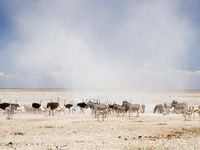When the first plumes of smoke rose above Namibia’s iconic Etosha National Park on September 22, 2025, few could have predicted the scale of devastation that would follow. Over the next week, a massive wildfire—fueled by high winds and the driest season in the region—swept across more than a third of the park’s sprawling landscape, leaving behind scorched earth, charred trees, and a shaken nation.
Etosha National Park, renowned as one of Africa’s largest and most beloved wildlife reserves, found itself at the heart of a crisis. According to the Associated Press, the fire rapidly burned across approximately 30% of the park’s 8,600 square miles (22,200 square kilometers), with the Namibian Environment Ministry later estimating that nearly 3,000 square miles (7,700 square kilometers) of vegetation had been lost. Other government sources, cited by BBC and Reuters, placed the burned area at about 775,163 hectares, or roughly 34% of the park—an expanse roughly the size of the US state of Connecticut.
For a country accustomed to arid conditions, wildfires aren’t entirely unexpected. Experts, as quoted by the BBC, note that fires can play a natural role in maintaining the health of savannah ecosystems. But this blaze was different—its ferocity and reach were unprecedented, and the destruction it wrought was anything but routine.
Namibia’s government responded with urgency. On Saturday, September 27, authorities convened an emergency meeting. Prime Minister Tjitunga Elijah Ngurare announced via X (formerly Twitter) that the decision had been made to send 500 additional troops to support exhausted firefighters, police, and volunteers already on the ground. This contingent joined a first group of 40 soldiers who had been deployed the previous day, as detailed by the office of President Netumbo Nandi-Ndaitwah. Helicopters and water trucks were dispatched to the front lines, and the sight of uniformed soldiers battling flames became a common scene across the park’s northern reaches.
Despite the scale of the response, the fire’s toll on wildlife was immediate and heartbreaking. State broadcaster NBC aired footage of antelope fleeing the flames, and the Environment Ministry confirmed that at least nine antelope and one elephant had perished in the inferno. The park is home to 114 mammal species—including the critically endangered black rhinoceros—and hundreds of migratory birds such as flamingos, which flock to the famed Etosha salt pan during the rainy season. The full extent of animal casualties remains unknown, but authorities acknowledged that the ecological damage was “extensive.”
The fire didn’t stop at the park’s boundaries. It spread into villages on the outskirts, destroying grazing pastures in the Omusati and Oshana regions near the Angolan border. Miraculously, no human casualties were reported, though the loss of pastureland has raised concerns for local farmers and their livestock.
As the flames raged, questions swirled about the cause of the disaster. Both the Environment Ministry and various news outlets, including the BBC, pointed to a likely culprit: a charcoal production business operating just outside the park’s boundaries. While the precise origin is still under investigation, officials believe sparks or embers from the site ignited the tinder-dry vegetation, setting off a chain reaction that quickly spiraled out of control. The timing couldn’t have been worse, coming at the peak of Etosha’s dry season, when grasses and shrubs are at their most flammable.
Opposition voices in Namibia’s parliament were quick to criticize the government’s handling of the crisis. MP Likando Rodrick publicly chastised authorities for what he described as a lack of preparedness and called for stronger long-term measures to prevent similar catastrophes in the future. “They should have been better prepared,” Rodrick insisted, urging the administration to rethink its approach to wildfire management in the face of increasingly unpredictable climate conditions.
Yet, even as the debate raged, the firefighting effort pressed on. By Monday, September 29, Environment Minister Indileni Daniel was able to deliver a sliver of good news. Speaking to Namibia Broadcasting Corporation, she declared, “Fire is now contained.” Minister Daniel reported that while most of the blaze had been extinguished, small flare-ups continued to pop up in isolated spots, prompting teams to remain vigilant and ready to respond. “We have noticed some new fires at one spot only, the team has been already dispatched,” she added.
Etosha National Park, stretching across more than 22,000 square kilometers (with some sources citing up to 22,935 square kilometers), is not just a wildlife sanctuary—it’s a cornerstone of Namibia’s tourism industry. Drawing about 200,000 visitors annually, the park’s vast salt pan is so large it’s visible from space, and its seasonal transformation into a shimmering lake is a magnet for both animals and tourists. The potential long-term impact of the fire on tourism and the local economy is still being assessed, but officials are hopeful that the park’s resilience—and some help from nature—will speed the recovery process.
For now, the focus remains on recovery and reflection. Firefighters and soldiers continue to patrol the park, dousing hotspots and monitoring for flare-ups. Environmental scientists are beginning the painstaking work of surveying the damage, counting animal losses, and planning for habitat restoration. There are also calls for stricter regulation of activities—like charcoal production—near protected areas, and for better firebreaks and early-warning systems to catch future blazes before they can spread.
While wildfires are a fact of life in Namibia’s arid landscapes, this one has left a deep mark. It’s a reminder of both nature’s power and its fragility, and of the delicate balance between human activity and the wild spaces that define the country’s identity. As the last embers cool in Etosha, Namibia faces a reckoning: how to protect its natural treasures in a changing world, and how to ensure that the next fire doesn’t burn quite so bright—or so far.
